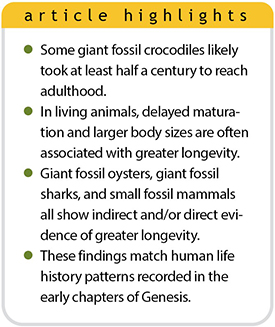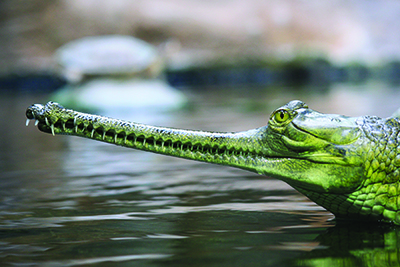 ICR research continues to discover evidence that at least some fossil creatures experienced extremely long lifespans like those recorded for the early Genesis patriarchs. A recent ICR Creation Science Update article discussed small extinct fossil mammals that lived much longer and took longer to mature than similar-size living mammals.1
ICR research continues to discover evidence that at least some fossil creatures experienced extremely long lifespans like those recorded for the early Genesis patriarchs. A recent ICR Creation Science Update article discussed small extinct fossil mammals that lived much longer and took longer to mature than similar-size living mammals.1
This makes sense. Assuming that this early longevity was not miraculous, any mechanism or mechanisms that enabled extreme human longevity would likely also have affected the animal kingdom. In two technical papers, I presented direct and indirect evidence for extreme longevity in giant fossil oysters and sharks.2,3 And a new paper describes how giant fossil crocodilians also show indirect evidence of great longevity. 4,5 By counting growth bands in bony skin plates called osteoderms, paleontologists have concluded that the giant crocodile-like animals Deinosuchus and Sarcosuchus imperator took at least 50 to 60 years to attain their full adult body sizes.
Genesis strongly hints that pre-Flood humans took longer to sexually mature since the youngest two ages at which Genesis 5 patriarchs are listed as having sons are 65 and 70.6 It is difficult to imagine pre-Flood humans undergoing puberty around 13, like today’s humans, and choosing to wait 50 years or more to get married!

If pre-Flood humans experienced delayed sexual maturity, they may have also experienced delayed skeletal maturation. Biologists have long noted that biological timescales, such as ages at sexual or skeletal maturity, lifespans, etc., tend to vary as adult body mass raised to the 1/4 power.7 So, one would expect delayed skeletal maturity to accompany delayed sexual maturity. Moreover, longevity studies of living animals have shown that delayed maturation and larger adult body sizes are often linked to greater longevity. Hence, the delayed skeletal maturation of these giant fossil crocodilians is indirect evidence of greater past longevity.
These two giant fossil crocodilians may or may not be ancestors of today’s crocodiles and alligators since they had some unique anatomical features not found in today’s crocodilians. However, the giant fossil crocodilians Gryposuchus croizati and Euthecodon brumpti both had long, narrow snouts that are very similar to the snouts of living gharials. Evolutionary scientists attribute this similarity to “convergent evolution,” in which the same body features coincidentally evolve in unrelated creatures.
But what if G. croizati and E. brumpti are simply giant pre-Flood gharials? Given that they had body sizes comparable to those of Deinosuchus and Sarcosuchus imperator, they very likely also had comparable lifespans and ages at maturity. Likewise, Purussaurus brasiliensis had a body shape very similar to that of living caimans. Was it simply a giant, long-lived, pre-Flood caiman? I am very encouraged by this research, and I hope you are, too. As former ICR President Dr. John Morris used to say, “It’s a great time to be a Bible-believing Christian!”
References
- Hebert, J. Methuselah-Like Longevity in Pre-Flood Mammals. Creation Science Update. Posted on ICR.org October 7, 2024, accessed December 17, 2024.
- Hebert, J. 2024. Crassostrea Oyster Fossils Show Evidence of Extreme Longevity. Creation Research Society Quarterly. 60 (3): 171–190.
- Hebert, J. 2024. Giantism and Delayed Maturation in Fossil Sharks: Evidence for Extreme Longevity? Creation Research Society Quarterly. 60 (4): 267–283.
- Hebert, J. 2025. Fossil Crocodilians Grew Larger and Longer, and Lived Longer than Extant Crocodilians. Creation Research Society Quarterly. 61 (3): 172–188.
- The Creation Research Society has graciously made the fossil oyster, shark, and crocodilian papers “open access” so that they may be freely read at creationresearch.org/crsq-by-decade.
- The third-youngest age at which a Genesis 5 patriarch is listed as having a son is 90. So it seems likely that the three sons whose fathers were 65 and 70 at their births were born early in their fathers’ reproductive lives. Hence, even if these three sons were not firstborn, early humans were apparently still taking a long time to mature sexually.
- Calder III, W. A. 1984. Size, Function, and Life History. Cambridge, MA: Harvard University Press, 139–161.
Stage image: Deinosuchus grew to over 30 feet in length
Stage image credit: Copyright © Andrey Atuchin, CC BY-SA 4.0. Used in accordance with federal copyright (fair use doctrine) law. Usage by ICR does not imply endorsement of copyright holder.
* Dr. Hebert is a research scientist at the Institute for Creation Research and earned his Ph.D. in physics from the University of Texas at Dallas



















